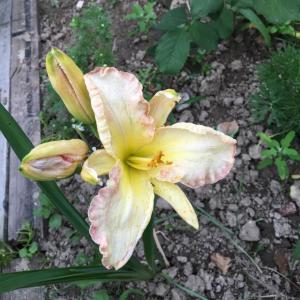Posts (312)
气泡布鲁鲁
09-03

The Essence of Being Present
Living in the present moment is a profound, yet often overlooked, aspect of life. It's about fully immersing yourself in the current experience, shedding the layers of past memories and future anticipations. This mindfulness practice leads to a heightened awareness and appreciation of life as it unfolds.Psychological Benefits: A Balm for the Mind
Engaging actively with the present moment can significantly enhance mental well-being. It aids in diminishing the stress of past regrets and future anxieties, fostering a peaceful state of mind. This mindfulness approach encourages a positive outlook, helping to alleviate symptoms of stress, anxiety, and depression.Breaking Free from the Shackles of Time
Living in the past or future can cloud our perception of the now. Releasing the hold of past disappointments and future worries can liberate us, allowing for a richer, more fulfilling experience of the present. It's a conscious choice to focus on the here and now, acknowledging but not being held captive by past or future thoughts.Practical Approaches to Mindfulness
Practicing mindfulness can be incorporated into daily life through simple activities. Mindful breathing, where focus is placed on each breath, can anchor you in the present. Similarly, engaging fully in routine tasks, like feeling the water during dishwashing, can transform mundane activities into moments of mindfulness.Deepening Relationships with Present Engagement
Being fully present also deepens interpersonal connections. By giving your undivided attention in conversations, you foster stronger bonds and deeper understanding with others. This active presence can transform relationships, promoting a greater sense of empathy and connection.Gratitude: Celebrating the Present
Cultivating a sense of gratitude for the present moment enriches everyday life. Recognizing and appreciating the simple joys and successes of the day, no matter how small, nurtures a mindset of abundance and positivity.Embracing Uncertainty and Letting Go
The practice of living in the present involves accepting life's uncertainties. Letting go of the desire to control every aspect of the future fosters resilience and adaptability, allowing for a more relaxed and open approach to life's unpredictabilities.Physical Wellness through Mindfulness
Mindful living has tangible benefits for physical health. It can lower the risk of hypertension, aid in pain management, improve sleep quality, and strengthen the immune system. This holistic improvement is often a result of reduced stress and a more balanced lifestyle.Boosting Productivity and Clarity
Focusing on the present improves concentration and productivity. By dedicating full attention to one task at a time, tasks are completed more efficiently and effectively, leading to a sense of accomplishment and reduced feelings of being overwhelmed.Conclusion: A Path to Joyful Living
Embracing the present moment is a journey towards finding joy and contentment in everyday life. It's about appreciating life's simple pleasures, connecting deeply with others, and experiencing a sense of peace and fulfillment. In a world that's constantly rushing towards the next big thing, present moment living is a gentle reminder to slow down and savor the journey.
Article
气泡布鲁鲁
09-03

The Modern Challenge: Juggling Work and Personal Life
In today's fast-paced world, individuals often find themselves caught in the tug-of-war between professional responsibilities and personal aspirations. The rise of technology, while offering immense flexibility, also blurs the boundaries between office hours and personal time. This omnipresent connectivity, combined with societal pressures to excel in all spheres, can lead to burnout, decreased productivity, and strained relationships. Recognizing the importance of a well-balanced work-life dynamic becomes imperative in such a landscape.Work-Life Balance: Beyond Just Time Management
While managing time efficiently is a critical aspect of achieving work-life balance, it's not the only factor. True balance entails ensuring that both work and personal spheres are satisfying and fulfilling. It's about integrating work with life's passions, maintaining mental and emotional well-being, and ensuring that neither sphere is neglected to the detriment of the other.Benefits of Maintaining Equilibrium
1. Mental and Physical Well-being: Overexerting in the professional domain can lead to stress, anxiety, and health-related issues. A balanced approach fosters mental peace and promotes physical health. 2. Improved Productivity: Contrary to the misconception that longer hours equate to more work, a balanced approach often results in higher efficiency and better quality of work. 3. Enhanced Relationships: Devoting quality time to loved ones without the constant looming of work responsibilities strengthens bonds and fosters healthier relationships.Strategies to Foster Balance
1. Set Clear Boundaries: In an era of remote work and digital connectivity, it's essential to delineate work hours and personal time clearly. This might mean setting specific 'off-grid' times or having a dedicated workspace at home. 2. Prioritize Self-care: Whether it's pursuing a hobby, exercising, meditating, or simply relaxing, ensure you carve out time for self-rejuvenation. 3. Delegate and Say "No": Understand that it's impossible to do everything. Delegate tasks when possible, and don't hesitate to decline additional responsibilities that might upset your balance. 4. Stay Organized: Utilize tools and techniques like calendars, to-do lists, and time-blocking to manage your tasks effectively.The Changing Workplace: Companies Recognizing the Importance
Organizations globally are beginning to recognize the significance of work-life balance for their employees. Flexible work hours, mental health days, and creating a supportive work environment are steps companies are taking. They understand that a happy, balanced employee is more engaged, loyal, and productive.Conclusion: The Journey to Wholesome Living
Work-life balance is not a one-size-fits-all formula; it's a personal equilibrium that each individual must discover for themselves based on their unique circumstances and values. In modern living, where the rush never seems to abate, finding that balance is the key to a fulfilling, content, and wholesome life.
Article
气泡布鲁鲁
09-03

Understanding the Nature of Change
Change is an inevitable part of life, a constant that challenges our adaptability and resilience. Moving to a new environment, be it a different city, country, or even a new neighborhood, can bring about a whirlwind of emotions. From the excitement of new experiences to the anxiety of the unknown, each emotion plays a crucial role in our adaptation process. Recognizing that these emotions are natural responses can help us navigate them more effectively.The Psychological Impacts of Relocating
Relocating can stir a mix of emotions. While there's the thrill of exploration, there's also the grief of leaving behind the familiar. It's not just about the physical relocation; it's the uprooting from a known culture, community, and routine. This shift can lead to feelings of isolation, identity crisis, or even depression. Understanding these psychological impacts allows for better preparation and coping strategies, ensuring a smoother transition.Tips for Smooth Transitioning
1. Research Ahead: Familiarize yourself with the new location. Understand its culture, norms, and local attractions. This not only aids in practicality but also builds anticipation and reduces anxiety. 2. Establish a Routine: While spontaneity is refreshing, a basic routine provides a sense of normalcy and control amidst the chaos. 3. Connect with Locals: Engage in community events or join local groups related to your interests. This helps in forging new relationships and understanding local dynamics. 4. Stay in Touch: Regularly communicating with loved ones from your previous location provides emotional support and a connection to your roots.The Role of Flexibility and Open-mindedness
Embracing a new environment requires flexibility. Situations might not always unfold as planned, and unforeseen challenges can emerge. Approaching these with an open mind and a flexible attitude can significantly reduce stress. Being open to new experiences, cultures, and views broadens horizons and enriches personal growth.The Power of Positive Framing
Perception plays a pivotal role in our experience of any situation. Viewing the move as an opportunity rather than a loss shifts the mindset from resistance to acceptance. Positive framing enhances adaptability, fuels excitement, and fosters a sense of adventure.Seeking Support When Needed
There's no shame in seeking support. If adapting to the new environment becomes overwhelmingly challenging, consider seeking help. This could be in the form of counseling, joining support groups, or even attending workshops tailored for people in similar situations. Remember, seeking help is a sign of strength, not weakness.Conclusion: Embracing the Evolution of Self
Every new environment provides an opportunity to rediscover oneself, to evolve, and to grow. While the initial stages of relocation can be daunting, with time, most individuals find their footing, often emerging stronger and more enriched. Embracing change, therefore, is not just about adapting to a new physical space but about welcoming the evolution of one's self in that space.
Article
气泡布鲁鲁
09-03

Introduction
Living is a remarkable experience that encompasses a myriad of emotions, challenges, and opportunities. It is a journey filled with ups and downs, joys and sorrows, and countless moments that shape who we are. In this article, we will delve into the essence of living, exploring its meaning, significance, and the ways in which we can fully embrace and appreciate the beauty of existence.The Meaning of Living
Living goes beyond mere existence; it is the active engagement with the world around us. It is about experiencing the wonders of life, forming connections with others, and pursuing our passions and dreams. Living is about finding purpose and meaning in every moment, big or small, and making the most of the time we have.The Beauty in Everyday Moments
Often, we find ourselves caught up in the pursuit of grand achievements and extraordinary experiences, neglecting the beauty that lies within the ordinary. However, it is in the small and seemingly insignificant moments of life that true joy and fulfillment can be found. Whether it is savoring a cup of coffee in the morning, watching a sunset, or sharing laughter with loved ones, these simple pleasures remind us of the richness of living.The Power of Gratitude
Gratitude is a transformative practice that allows us to fully appreciate the gift of living. It shifts our focus from what is lacking to what is present, cultivating a sense of contentment and appreciation for the blessings in our lives. By practicing gratitude daily, we become more aware of the beauty that surrounds us, fostering a deeper connection with ourselves and the world we inhabit.Embracing Change and Growth
Living is synonymous with growth and evolution. We are constantly faced with new experiences, challenges, and opportunities for self-discovery. Embracing change is essential for personal development, as it allows us to learn, adapt, and expand our horizons. By stepping out of our comfort zones and embracing the unknown, we open ourselves up to endless possibilities and a life enriched with meaning and fulfillment.Living Authentically
Living authentically entails being true to ourselves and honoring our values, passions, and desires. It involves embracing our unique qualities and expressing them genuinely in all aspects of life. When we live authentically, we cultivate a sense of purpose and alignment with our true selves, leading to greater happiness and fulfillment.The Power of Connection
Living is inherently intertwined with our connections to others. Meaningful relationships and a sense of belonging are vital aspects of a fulfilling life. By fostering genuine connections with family, friends, and community, we enrich our experiences, find support in times of need, and create lasting memories. The power of human connection reminds us that we are not alone on this journey, and that collective experiences can bring us immense joy and fulfillment.Conclusion
Living is a gift that should be cherished and celebrated. It is about embracing the beauty of existence, finding joy in everyday moments, and growing as individuals. By cultivating gratitude, embracing change, living authentically, and nurturing meaningful connections, we can fully immerse ourselves in the vibrant tapestry of life. So, let us embark on this journey with open hearts and open minds, and make the most of the precious time we have been given.
Article
气泡布鲁鲁
09-03

Introduction
The place we call home, the sacred space where we retreat to unwind, refresh, and rejuvenate, comes in diverse forms and styles. From the cozy confines of apartments to the sprawling expanse of houses, each type of living space offers a unique blend of experiences, amenities, and atmospheres. In this comprehensive guide, we traverse the landscape of living spaces, offering insights, comparisons, and considerations to help you find the dwelling that resonates with your lifestyle, preferences, and needs.Apartments
Apartments are synonymous with urban living, offering a compact, convenient, and often, a more affordable living option. They are characterized by their location in multi-unit buildings, offering a variety of sizes from studio to multi-bedroom units.Pros
Apartments are often located in the heart of cities, offering proximity to workplaces, shopping centers, and urban amenities. They are typically easier to maintain, given their size, and often come with added security features and community amenities like gyms and pools.Cons
However, apartments can sometimes lack privacy and outdoor space. They may also come with restrictions set by landlords or property management, limiting customization and personalization of the space.Houses
Houses represent the quintessential family dwelling, offering space, privacy, and the freedom to customize and expand. They are diverse, ranging from quaint cottages to luxurious mansions.Pros
Houses offer greater privacy, ample outdoor space, and the freedom to modify and personalize the living space. They are ideal for families, providing room to grow, play, and entertain.Cons
However, houses typically involve higher maintenance efforts and costs. They may also be located further from urban centers, necessitating longer commutes and less access to urban amenities.Condominiums
Condominiums blend the convenience of apartment living with the ownership privileges of houses. Condo owners have individual ownership of their units while sharing common areas.Pros
Condos often come with enhanced security, maintenance services, and shared amenities like pools and fitness centers. They offer a sense of community while maintaining the privilege of ownership.Cons
Ownership comes with homeowners' association (HOA) fees, and condo owners must adhere to the rules and regulations set by the HOA. There might be limitations on personalization and modifications of the units.Co-Living Spaces
A relatively new entrant in the housing landscape, co-living spaces offer shared living arrangements, often targeting young adults, professionals, and students.Pros
These spaces promote community living, offering shared amenities and social opportunities. They are typically fully furnished, with utilities and maintenance included, making them convenient and hassle-free.Cons
Privacy can be limited in co-living spaces, and residents must be amenable to shared living arrangements, including communal spaces and amenities.Conclusion
The spectrum of living spaces is as diverse as the individuals seeking them. Each option, from the cozy apartment nestled in the vibrant heart of the city to the serene house set amidst tranquil suburbs, offers a distinct living experience. In this dance of choices, considerations of space, privacy, maintenance, location, and community converge, guiding each seeker to the dwelling that not just shelters but resonates with their lifestyle, aspirations, and needs.
Article
气泡布鲁鲁
09-03

Introduction
The enigmatic embrace of nature has long been lauded for its therapeutic effects on the human spirit. Verdant landscapes, serene bodies of water, and the symphonic sounds of wildlife don’t just allure aesthetically, but extend their tendrils into the intricate pathways of the human psyche, enhancing mental and physical well-being. This discourse elucidates the multifaceted impacts of nature on our holistic health, unraveling the tapestry where mental, emotional, and physical threads intertwine.The Serenity of Green Spaces
Green spaces, lush with flora and often marked by the calming presence of fauna, serve as sanctuaries of tranquility. Scientific studies have converged on the stress-relieving effects of these environments. The sounds of rustling leaves, the aromatic scent of blossoming flowers, and the visual feast of verdant expanses work in harmony to alleviate anxiety, depression, and stress.Mindfulness and Nature
Nature immersion is intricately linked to the practice of mindfulness. The natural environment fosters a state of present awareness, where each breath is a symphony of sensory experiences. Nature’s beauty facilitates a deepening connection to the present moment. This elevated consciousness is linked to enhanced mental clarity, improved concentration, and a tranquil state of mind.Physical Vigor and Vitality
Beyond the mental sphere, nature’s touch extends to physical vitality. Outdoor activities, often facilitated by enticing natural environments, enhance cardiovascular health, improve respiratory function, and foster overall physical endurance. Nature isn’t just a silent spectator; it’s an active participant, beckoning the human spirit into the dance of physical activity.Healing Power of Natural Elements
Water, earth, air, and sunlight; these elemental forces of nature wield a therapeutic touch. Sunlight, a natural source of Vitamin D, enhances bone health and immune function. The air in natural environments, rich in oxygen, invigorates the body’s cells. Nature’s elements are not just passive constituents of the environment; they are active alchemists of human health.Nature’s Influence on Emotional Resilience
Emotional well-being finds a staunch ally in nature. The sensory experience of nature invokes positive emotional responses. It transcends the ephemeral rush of positivity, embedding itself into the human emotional fabric, enhancing resilience, and equanimity. Nature’s visual and auditory experiences are emotional sonnets, articulating a language of peace, balance, and harmony.The Social Cohesion Fostered by Nature
Nature fosters social bonds. Parks and natural environments are communal spaces where social interactions flourish. These interactions are not trivial; they are instrumental in enhancing mood, fostering a sense of belonging, and enhancing the quality of social relationships. Nature is the silent orchestrator of social symphonies, where human connections are forged and nurtured.Nature and Cognitive Functionality
Cognitive functions are markedly enhanced by interactions with nature. Attention, memory, and cognitive flexibility are honed in natural environments. Nature is not just a passive backdrop; it is an active stimulant of cognitive processes, fostering mental agility, alertness, and cognitive endurance. Each natural element, from the intricate patterns of leaves to the harmonious sounds of wildlife, is a cognitive stimulant.Preserving Nature for Holistic Health
As the discourse on nature’s impacts on well-being unfolds, the imperative to preserve and nurture natural environments becomes paramount. Environmental conservation isn’t just an ecological necessity; it is a holistic health imperative. Each tree preserved, each body of water protected, is a step towards safeguarding the natural sanctuaries of holistic well-being.Conclusion
Nature is not a luxury; it is a profound necessity, intricately woven into the fabric of human mental, physical, and emotional well-being. Each natural element, each green space, and each interaction with the natural world is a step into the sanctuary of holistic health. In the embrace of nature, humanity finds not just an aesthetic retreat, but a home where the mind, body, and spirit find their harmonious symphony, where healing, peace, and vitality converge.
Article
气泡布鲁鲁
09-03

What Is Deep Teeth Cleaning?
Deep teeth cleaning to remove plaque and tartar from your teeth is an effective way to reduce gum inflammation and improve gum health. Plaque develops on the tooth’s surface. It contains bacteria and is developed when food particles combine with saliva. Plaque accumulates on teeth daily and can be removed by brushing them. However, plaque in between your teeth cannot be removed by brushing. The calcification or hardening of plaque leads to the formation of tartar. Gum disease can be brought on by plaque or tartar build up. This includes gingivitis, a gum condition characterized by inflammation. Without treatment for gingivitis, periodontitis can develop. This is a serious infection that destroys the bone that holds your teeth in place.How Does Deep Cleaning of Teeth Benefit You?
If gum disease causes your gums to move away from your teeth, leaving a space more than 5 millimeters (mm) deep, you might need a deep cleaning. Your gums and teeth may become further separated if gum disease worsens. Tooth loss or loose teeth may result from these conditions weakening the bones supporting your teeth. Dentists recommend deep cleanings for several reasons, including: 1. Preventing gum disease from progressing 2. Promoting healing and treating an infection 3. Keeping your teeth clean above and below the gum line 4. Getting rid of bad breath caused by gum disease 5. Protecting teeth rootsDo Deep Cleanings Have Any Disadvantages?
Deep cleaning can treat gum disease, but the procedure is not without risks. Deep cleaning teeth has the following disadvantages: 1. Nerve damage is possible 2. No assurance of your gums reattaching to your teeth 3. Gums may recede 4. Compromised immune system may result in possible infections 5. Pain and sensitivity In most cases, deep cleaning is associated with minimal risks. The effects typically last for only five to seven days. However, in extensive cases, this may extend to a few weeks.What Does A Thorough Dental Cleaning Entail?
There is a difference between routine and deep teeth cleanings. Plaque and tartar are removed from the upper gum line by a regular dental cleaning. In contrast, deep cleanings remove plaque and tartar from within the gum line. The gums and teeth can become separated when you have gum disease, causing tartar and plaque to accumulate between them. Getting rid of this build up requires cleaning beneath the gumline.Deep Cleaning Involves Gum Scaling and Root Planing
The deep cleaning involves gum scaling and root planing and usually takes two to three visits. Each visit may take between an hour and two hours to complete. Removing plaque and tartar from below the gum line during the tooth scaling appointment is necessary. During the root planning procedure, the dentist removes plaque and tartar build up around the roots of your teeth. As a result of this treatment, the amount of space between your teeth and gums will be reduced and your gums will be able to reattach to your teeth.Antibiotics may be necessary
You may need antibiotics for a few days when your immune system is compromised. The procedure may leave you susceptible to infection afterward. The release of bacteria into the bloodstream can also occur during deep dental cleanings.Does Deep Cleaning Hurt?
To minimize discomfort, the gums will be numbed with a topical or local anesthetic during teeth scaling and root planing. Depending on the treatment, you may experience some sensitivity following the procedure. There is a possibility that your gums will swell, and you may experience some minor bleeding as well.Reducing Sensitivity After the Procedure
It is recommended that in the first few days after the procedure, you should eat soft foods (yogurt, apple sauce, or mashed potatoes) to reduce sensitivity. It is also essential to avoid foods and beverages that are too hot or too cold. To reduce inflammation, it is advisable to take pain medications such as acetaminophen or ibuprofen while also rinsing the affected area with warm salt water. Maintaining good oral hygiene promotes healing and reduces gum inflammation. It is recommended to gently brush your teeth twice a day, and floss at least once.The Cost of Deep Teeth Cleaning
Depending on the severity of gum disease or inflammation, the cost of deep cleaning may vary. You may need two visits to remove tartar and plaque altogether, but some people may need as many as four. This type of cleaning is done in quadrants. According to where you live or how much treatment you require, you may have to pay $100 or more per quadrant. Deep cleanings are usually covered by dental insurance.Conclusion
Deep cleaning of the teeth promotes the healing of gum disease as well as the prevention of bad breath. It is important to be aware of the potential side effects or complications associated with deep cleanings. Even though this is a safe and standard procedure, there may be some swelling and sensitivity afterward. After your procedure, visit your dentist if swelling, bleeding, or pain persists.
Article
气泡布鲁鲁
09-03

A guide to brushing your teeth correctly
You can brush your teeth simply with a toothbrush with a nylon bristle and plastic handle. You should be able to complete the process in about two minutes. The more you practice, the more you will understand how long 2 minutes can feel when you are brushing your teeth. Water should be used to lubricate your brush. Apply toothpaste to the toothbrush head in a small amount, about the size of a pea. Brush your front teeth with a gentle, short stroke while angled 45 degrees toward your gums. Don't forget to brush your chewing surfaces, back molars, and the outer sides of your teeth. Your top front teeth should be cleaned from the inside by flipping the toothbrush upside down. Your bottom front teeth inside the surface can be accessed by flipping the toothbrush over. While brushing your teeth, brush your tongue to remove any plaque or bacteria that has built up there. In a clean sink, swallow toothpaste remnants, saliva, and water. Cold water should be used to rinse your mouth afterward.Take care of your braces while brushing
A few extra steps are involved in brushing your teeth when you have braces. •If you have removable braces or rubber bands, remove them first. If you want to reapply them, you need to rinse them first. •A small amount of toothpaste and some water should be added to your toothbrush. •Ensure you clean under your wires and pins as well as around your braces. •Your braces' wires should be brushed regularly to prevent plaque and bacteria from forming. •Be sure to brush your teeth for at least two minutes moving from one side of the mouth to the other. •The tongue should be gently brushed. •If there is any toothpaste or saliva left, spit it out. Make sure your braces are clean by rinsing with water and checking the mirror.What your children should do when brushing their teeth
You might want to consider fluoride-free toothpaste or toothpaste with much less fluoride for children under 3 years old. Until their teeth have fully erupted, a baby's teeth may start to decay, so teach them good dental hygiene early. You should use a soft, child-sized toothbrush, water, and a pea-sized or rice grain-sized smear of toothpaste (if your child is under 3). Your child should brush their teeth slowly from back to front and sides. If their teeth haven't erupted yet, brush their gums as well. Make sure to brush your child's tongue. Have them practice rinsing their mouth and spitting out their toothpaste.Brushing without toothpaste: How to do It
There are several ingredients to consider when selecting toothpaste, whether you are traveling and forgot to bring it or just looking for a better natural way to brush your teeth.Using coconut oil is beneficial
Coconut oil has antibacterial properties, so it's effective at fighting bacteria in your mouth. As an alternative to toothpaste, it can also dissolve plaque. Gum disease and tooth decay are also prevented by it. The benefits of coconut oil are overshadowed by the downsides of using fluoride in your toothpaste. However, it can still be used for "oil pulling" and brushing your teeth.The active charcoal
In a hotel, for example, if you're without toothpaste late at night, this option might not work since most people don't have extra activated charcoal tablets lying around. You can, however, clean your teeth with activated charcoal toothpaste and pure activated charcoal. However, activated charcoal wears down enamel and can be abrasive, so it shouldn't be used daily. In addition, it lacks fluoride, which makes it more likely you will decay your teeth if you choose this toothpaste instead of your traditional fluoride toothpaste.Sodium bicarbonate
Baking soda is often added to toothpaste to enhance its whitening capabilities. Your teeth can be cleaned with baking soda by removing stains. Plaque is also removed effectively by it. Suppose you run out of toothpaste for the night and are in a pinch. In that case, you might consider using a baking soda paste as an alternative. Since baking soda does not contain fluoride, you will miss out on the enamel-protecting benefits of fluoride over time. Finally, brushing your teeth may look different depending on what stage of your life you are in. What's certain is that brushing your teeth shouldn't be avoided or skipped under any circumstances. Keeping your teeth healthy and your smile bright is as simple as brushing twice a day for 2 minutes each time.
Article
气泡布鲁鲁
09-03

How to floss?
1. Cut dental floss into 18-24 inches pieces. Your middle fingers should be wrapped around most of the floss in order to hold it correctly. If you are flossing your teeth, the floss you need should only be 1 or 2 inches long. Keep your thumb and index fingers tight as you hold the floss. 2. You should insert dental floss between two teeth. Brush both sides of each tooth with the floss, gliding it up and down. The floss should not touch your gums. Your gums may be scratched or bruised as a result. 3. When the floss reaches your gums, it should be wrapped around your teeth. In this way, floss can reach the cavity between your teeth and gums. Moving from one tooth to another, repeat the steps. Make sure each section of floss you use is clean and new for each tooth.When you have braces, how should you floss?
When you have braces, flossing can be a challenge, and it takes more time than when you don't have braces. Flossing your teeth with regular floss should take you between 10 and 15 minutes. You should instead use waxed floss with braces so that it won't tear or get stuck in your braces. Waterpiks, a type of water flosser, and floss threaders are other options you can use to floss under braces instead of waxed floss. Flossing can be made easier with both.What is the best time to floss?
A healthy mouth also depends on knowing when to floss. Brushing teeth first and flossing afterward is common among some people. Generally, though, it's recommended to floss before brushing. Brushing removes foreign objects from your mouth, but flossing helps lift them out. By brushing first and flossing afterward, you will not be able to remove the food and plaque from your mouth until you brush again. Daily flossing is recommended according to the American Dental Association in order to keep your teeth healthy.What types of dental floss are available?
You can choose from different types of dental floss. If you have braces or bridges and have enough space between your teeth, it is best to use floss that is suitable for you. Dental floss can be used more easily in wide spaces than in tight spaces depending upon the type.There are several types of dental floss, including:
1. Tape for dental use. If you have braces, gaps, or large spaces between your teeth, this type of dental floss is broader and flatter like a ribbon. 2. An ordinary floss. This nylon strand is thin and easily fits between teeth. Flavored or unflavored, waxed or unwaxed, it comes in different shapes and sizes. 3. With wax-coated dental floss, it is easier to get between teeth that are close together. 4. There are super flosses. With this floss threader, you can thread dental floss around gapped teeth, orthodontic braces, and bridges. You can floss underneath appliances with the stiffened end, around devices with spongy floss, and underneath your gum line with regular floss.Other tools to make flossing easier
Furthermore, waxed floss, floss threaders, and other tools can make flossing easier and faster. Electric flossers or water flossers remove plaque and food between teeth using water and pressure. It is an excellent option if you find it challenging to use regular floss, as they are both great alternatives. Braces can also benefit from a water flosser. Wires and brackets can be cleaned with this device. Disposable floss picks are another option. Flossing the back of your mouth can be difficult without these tools, but they make flossing a breeze. Therefore, the importance of good oral hygiene goes beyond brushing your teeth. The process of keeping your teeth clean also includes flossing your teeth on a regular basis. You can protect your teeth from decay and gum disease by regularly flossing and removing bacteria, plaque, and food between your teeth. Regular dental cleanings should be scheduled at least twice a year in addition to regular brushing and flossing.
Article
气泡布鲁鲁
09-03

So, what exactly causes bad breath?
The cause of bad breath is typically bacteria in the mouth. In most cases, poor dental hygiene contributes to bad breath. When you eat, your teeth get clogged up with food, and these bits of food grow bacteria that produce sulfur compounds that stink. Brushing and flossing frequently are essential for maintaining a healthy mouth because bacteria continue to grow in your mouth, building up a thin film called plaque on your teeth. When plaque isn't brushed away at least twice a day, it produces a foul odor and leads to another smelly process known as tooth decay.How can bad breath be eliminated?
Depending on the severity of your bad breath, there are several ways to treat it.Maintaining good oral health
Researchers have found that bad breath is most often caused by poor dental hygiene. Keeping teeth healthy means brushing them twice a day for two minutes, using fluoride toothpaste (morning and night). Preventing plaque buildup is essential for maintaining a healthy mouth. Some believe brushing after every meal is necessary to prevent decay and bad breath. The tongue can also accumulate bacteria, causing it to smell foul. This thin layer of film can be removed by tongue scraping. What is tongue scraping, you might ask? Tongue scraping is when you brush or scrape your tongue with your toothbrush or a tongue scraper. This can also be done two times a day.Stay hydrated
The causes of bad breath are often connected to mouth dryness. Sleeping naturally dries out your mouth, which is why morning breath is usually worse. A daily intake of eight glasses of water is recommended in order to stay hydrated. When your mouth feels dry, drink plenty of water (don't drink juice or soda since these can dry your mouth out even more). In addition to keeping your mouth clean, saliva inhibits the growth of bacteria that cause bad breath. The saliva in your mouth is essential for keeping it clean as bacteria thrive without it. Bad breath can also be naturally treated by gargling salt water. For every 8 ounces of warm water, add half a teaspoon of salt. Give the mixture a swig and spit it out after 30 seconds. As needed, repeat the process.Using apple cider vinegar
Does your breath smell of onions or garlic? The best way to eliminate breath odors is by mixing apple cider vinegar with water and swishing it around the mouth. Make sure you gargle for 30 seconds before spitting it out.Milk and yogurt
Believe it or not, bad breath can also be treated with milk and yogurt. According to some sources, drinking milk after eating garlic improves "garlicky" breath significantly. One serving of plain, nonfat yogurt daily will help you fight bad breath. As soon as you finish a meal containing strong-smelling foods like garlic or onions, drink a glass of milk. Lactobacillus, a healthy bacteria found in yogurt, can also support the body, like your gut.Maintain a healthy diet by eating fruits and vegetables
How can fruits and vegetables freshen your breath? Using apple, celery, and carrots as brushes, your teeth can be cleaned naturally. Several studies have indicated that raw apples can help combat garlic breath. Garlic's foul-smelling compounds are neutralized by some natural compounds in apples. In addition to deodorizing the mouth, it balances the compounds in the bloodstream, which is especially beneficial for people with persistent garlic breath. Vitamin C in oranges promotes good dental hygiene by increasing saliva production. In the absence of saliva, foul-smelling bacteria cannot be washed away, which is why many people suffer from bad breath. Oranges are among the fruits rich in vitamin C. Oranges make a healthy dessert and promote good dental hygiene simultaneously.Zinc
It is possible to counteract bad breath with zinc salts, commonly found in mouthwashes and chewing gum. Zinc-containing solutions can be effective for at least 6 months in reducing bad breath when rinsed regularly. Try a zinc chewing gum designed for people with dry mouths. Alternatively, dietary zinc supplements can be bought online or at local drug stores.You can chew gum
Gum helps clean your mouth of nasty bacteria and leftover food particles by stimulating saliva production.How to know when to consult a doctor
Improved dental hygiene can treat most cases of bad breath originating in the mouth. Nevertheless, some cases of bad breath are signs of more severe health conditions, such as diabetes ketoacidosis, kidney failure, or infections. Consult your dentist or doctor if you don't see improvement in your bad breath with home treatment.
Article
Related Users
Elite Article


























